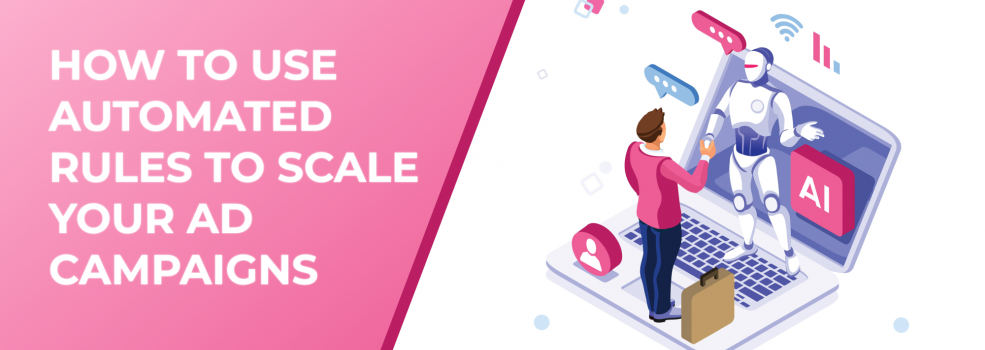During the process of running ad campaigns online, you need to constantly monitor ad performance and optimize them to get better results. This can require a lot of time and attention, and you might be at risk of not making the necessary adjustments to your ads quickly enough to avoid losing money.
No matter whether you’re a small business owner, a freelance advertising specialist, or a marketing department head working in a big agency, you can probably benefit from automating some marketing tasks that you or your team tackle on a daily basis.
Rules will automate repetitive tasks connected with ad management with ease, providing you with an opportunity to focus on something more creative and strategic.
In this article, we’re going to explore why automated rules can be crucial for running successful ad campaigns and explore the most effective way to use them, taking the AutomatedRules platform as an example. But first, we need to understand what automated rules are and why we might need them.
What are the benefits of automated rules?
The performance of ad campaigns depends on multiple factors that make it difficult to keep track of everything that happens to your ads. However, automated rules can provide a way to make ad management process a lot easier.
For freelance advertisers and small business owners, automated rules is a cost-efficient way to manage their ad campaigns without spending a fortune on expensive software or hiring additional staff. Automated rules can save their time and resources, ensuring that their ad campaigns are always performing at their best and their ROI keeps increasing.
For marketing agencies, automated rules can offer an opportunity to manage thousands of ad campaigns for numerous clients across different platforms at the same time. Rules will help them maintain optimal performance levels for all campaigns, deliver consistent results to their clients, and save time for brainstorming and strategic thinking.
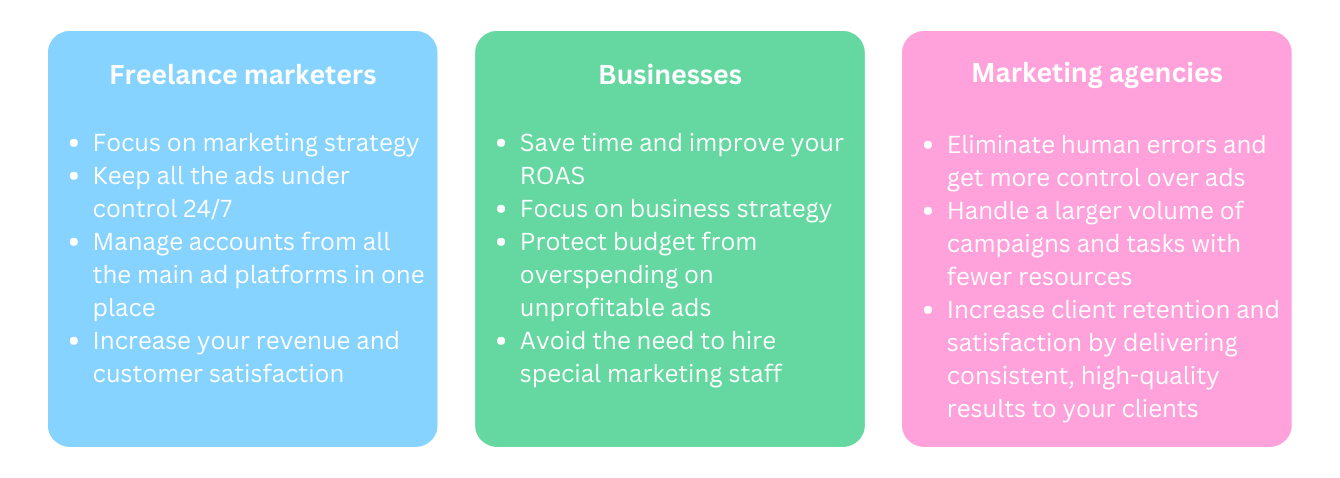
In general, here’s what automated rules can help you with:
1. Saving time because you're automating repetitive tasks that require a lot of time but can be performed quickly by automation tool. You won't need to constantly check your Ads Manager once the rules are set.
2. Saving money. By setting rules, you avoid wasting your budget because no human can react to ad performance changes faster than automation. You can stop ads that are spending too much without bringing any profit, or increase the budget for top-performing ones. It also allows businesses to avoid the need to hire additional staff to handle ad management.
3. Eliminating human errors and improving ad performance. With rules you get more control over your ads, pausing unproductive ones and scale those driving more conversions. All you need to do is to define your advertising strategy and KPIs – then you can just sit back and let automated rules micromanage your ads for you.
In short, automated rules will help you achieve more with fewer resources, be more productive and efficient, and free up your time to take more clients and focus on strategic and creative tasks.
How automated rules work?
Many advertising platforms provide the automated rules feature to assist you in managing your ads. For example, all major platforms like Facebook, TikTok, Google, and others have made automated rules available for their users.
So, how do automated rules work?
Essentially, they consist of:
a) conditions that you can set based on specific performance metrics tailored to your campaign objective, and
b) actions that are triggered automatically when a specific condition or a group of conditions are met.

For example, you can set a rule to pause your ads when they don't bring you the expected results while spending your budget, or scale ads that perform well and don't cost you too much.
Without this rule, you’ll have to manually monitor the performance of all ad sets and adjust their budgets on a regular basis, and this can take a lot of time and attention to detail. AutomatedRules makes this process much easier, allowing you to focus on other areas of your campaign.
Why choose AutomatedRules?
It’s important to note that automated rules are still not available on certain advertising platforms, and many platforms that do have them often lack a lot of helpful features.
That is why we would recommend using third-party tools like AutomatedRules – they can offer you a much more advanced and customizable version of automated rules.
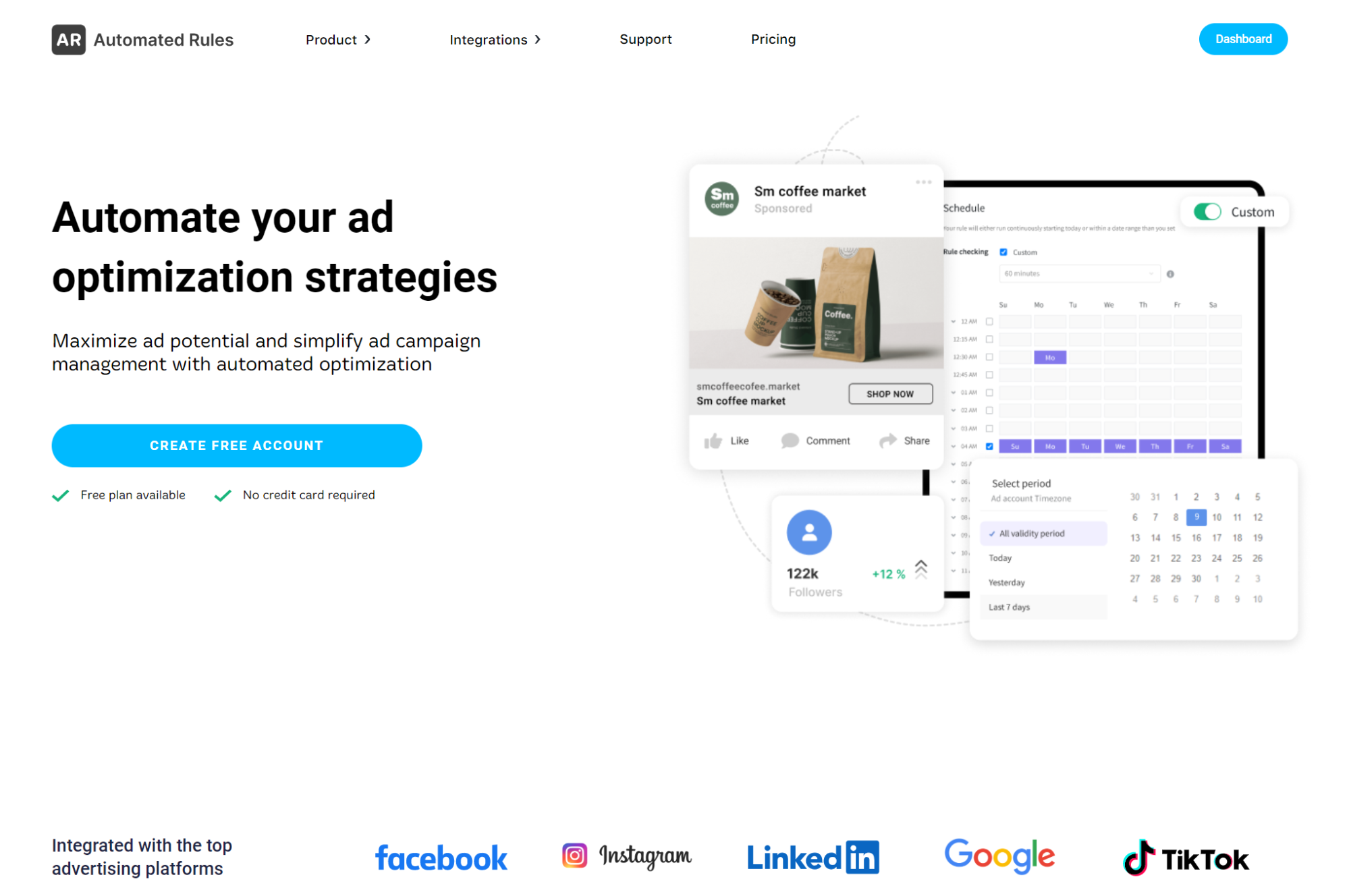
Here are their main benefits of using AutomatedRules:
- It integrates with all the most popular advertising platforms like Facebook, Instagram, Google, TikTok, LinkedIn, Snapchat, and Twitter, so you can manage all your ad campaigns in one place.
- It offers a lot of features for customizing your rules. For example, you can create custom metrics and choose custom timeframes for checking rule conditions, nest or group conditions to make complex rules, duplicate or delete items, and so on.
- With it, you can create a lot more rules than with native tools. For example, the number of rules that can be created via Facebook's Ads Manager is limited, while on AutomatedRules you can create hundreds and thousands of rules.
In short, third-party tools like AutomatedRules allow you to manage your ad campaigns across several platforms from one place and provide all of the necessary features for making your rules as customized and complex as you need them to be.
Essential automated rules for managing ads more effectively
To get an idea of how you can apply automated rules in your case, it might be helpful to go through the most popular rules that are used by many advertisers to manage their campaigns.
Now, let’s go through some basic rules that can help you cover all major ad management tasks:
- Rules that stop low-performing ads, ad sets, or campaigns
Rules like that automatically pause ads that are not performing well based on predefined conditions (for example, if ads have low click-through rates or conversion, high costs per action, etc.). This can help you avoid spending ad budget on ads that are not generating the results you’re looking for.
For example, you can set a rule to pause campaigns that haven’t generated any sales during a specific period of time after you spent too much budget on them.
Here’s how this rule might look on AutomatedRules: the ad campaign will be paused if it has spent more than $100 during the last week while generating no purchases and having low ROAS.
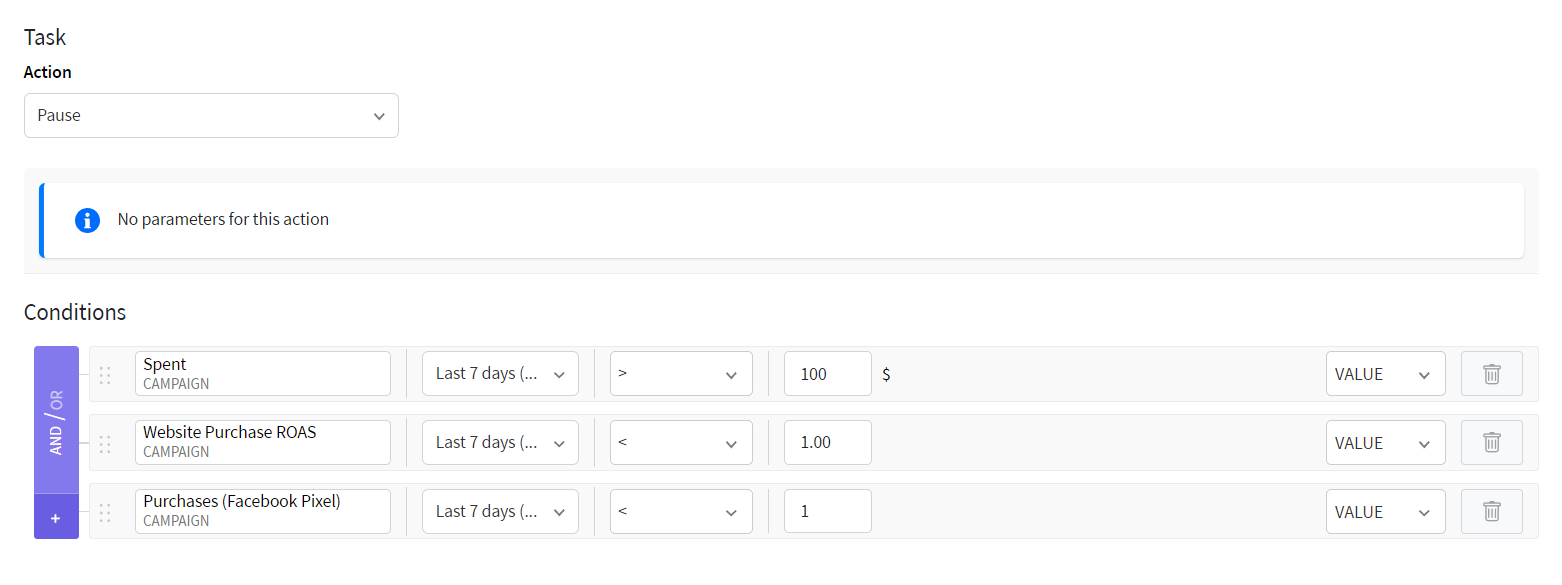
- Rules that scale top-performing ads, ad sets, or campaigns
This type of rules can automatically increase the budget for ads that are performing well. This will help you maximize your ROI by allocating more budget to ads that are generating the best results.
For example, you can set a rule for increasing your campaign’s budget when it’s generating sales while not costing you more than the profit you generate from it.
Here’s how this rule might look: the budget will be increasing by 15% once a day in case the campaign has generated more than 5 sales during the last week while the cost per action did not exceed its optimal level. To make sure that you don’t overspend, you can set the maximum budget cap (e.g. $1000). Once the budget reaches its maximum value, it will stop being automatically increased.
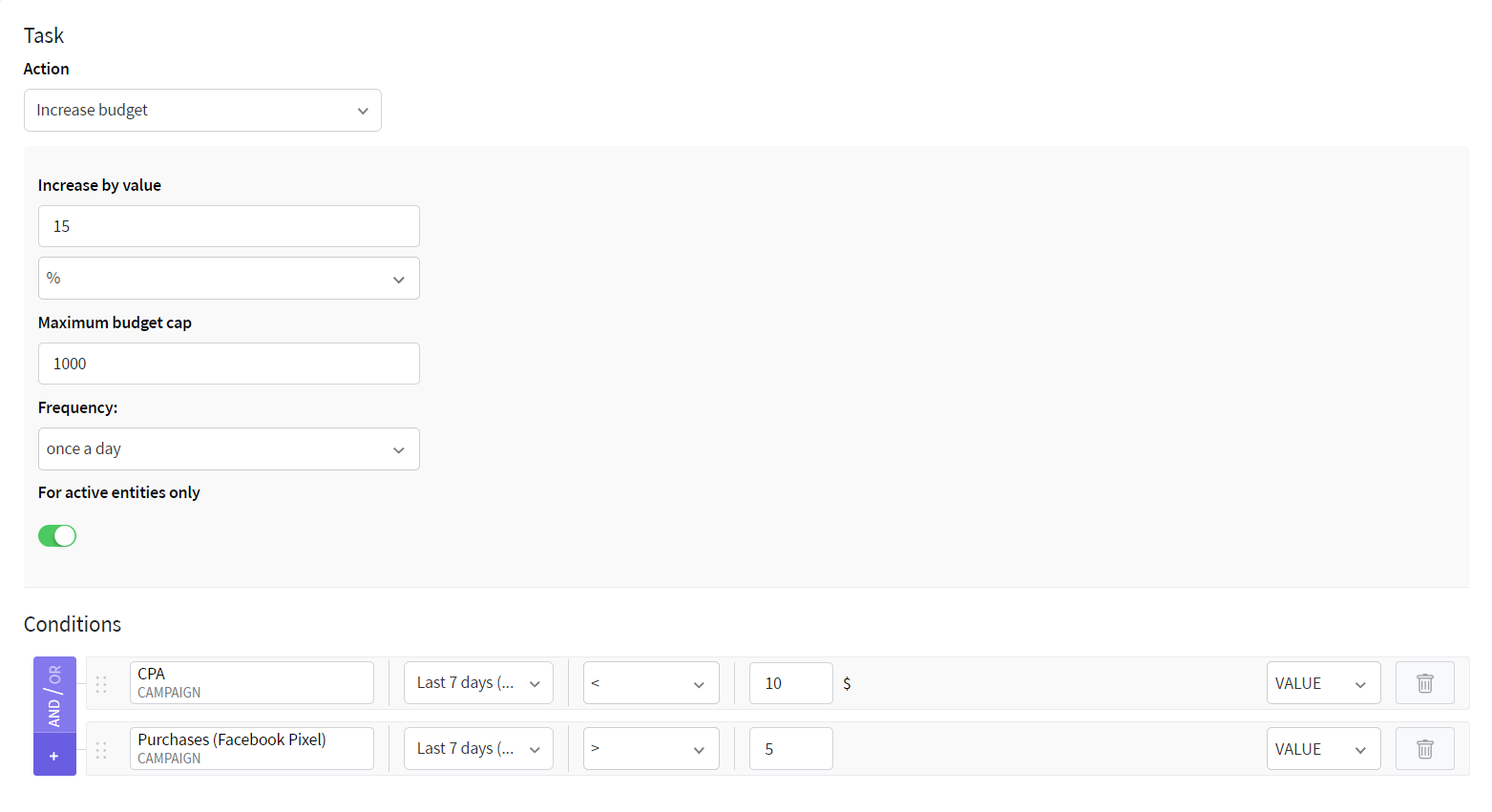
- Rules that allow you to run ads on a custom schedule
This type of rules can help you run your ads only during times when the conversion rates were proven to be higher. For this, you’ll need to set one rule for starting your ads at specific hours and a rule for pausing them. This can help you spend your ad budget more wisely and improve the conversion-rate ranking.
For example, if you’re advertising your restaurant and want to reach a target audience that consists of office workers, you might want to run your ads during hours when they get off their jobs.
First, you’ll need to create a rule that will let your ads start running after 6 p.m. The rule task and condition will look like this: if time is greater than 5 p.m., the ad campaign will start running.

It’s also important to set the right rule checking frequency: in this case, your rule’s condition should be checked every day at 6 p.m.
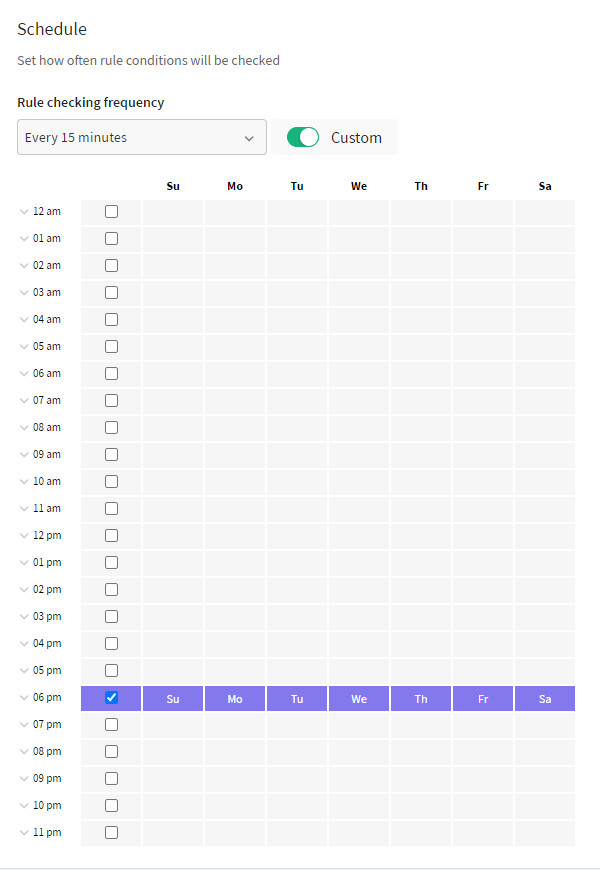
Then, you’ll need to set a rule for pausing your campaign to make sure that it doesn’t run at times when everyone’s already asleep. The rule task and condition can look like this: if time is less than 2 a.m., the ad campaign will be paused.

For this rule, the condition should be checked at 1 a.m.
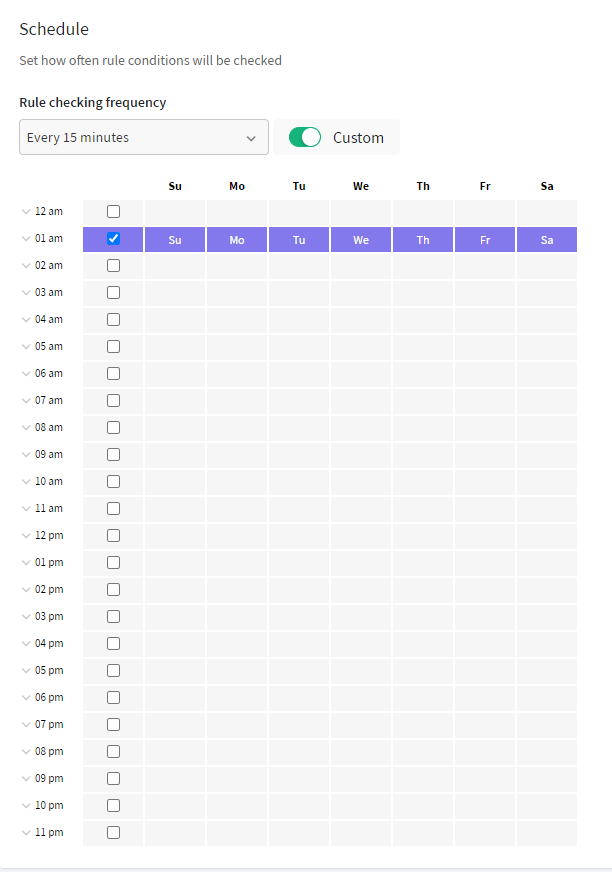
These are the most popular automated rules, and when you set them, you can be sure that your campaigns will run smoothly while you’re busy with other tasks.
Finally, let’s consider some recommendations on how to use automated rules successfully.
Tips for using automated rules
While automated rules are undoubtedly very helpful, it might not be easy to achieve perfection instantly if you don’t have prior experience.
Here are some tips that can help you get the most out of your rules:
1. Define your advertising strategy and KPIs in advance
Decide what you want to achieve with your ads and select the most important metrics for estimating your ad performance objectively. This will help you create rules that are tailored to your goals and ensure that your ads are optimized to achieve them.
2. Start small
It’s better to begin by creating just a few automated rules to see whether they help you meet your objectives, and only then start to introduce new rules. This will help you gain a deeper understanding of how automated rules work and how they can benefit your advertising efforts.
3. Monitor performance
Even automated rules need some human oversight. This means that you’ll need to keep an eye on how your automated rules are performing and adjust them according to your marketing strategy.
4. Test different rules
Experimenting with different automated rules will help you figure out which ones work best for your campaigns. If you find the right combination of rules, you can significantly improve ad performance and maximize your results.
5. Rely on ad performance data to make decisions
Using objective performance data can help you make better decisions when creating and adjusting automated rules. You can look at metrics like ROAS, CTR, conversion rates, etc., to optimize your ads more effectively.
Conclusion
Hopefully, by now you can see why automated rules have become a must-have tool for optimizing both your ads performance and overall budget. If you’re ready to try them out, you can follow the recommendations and tips we have provided in this article to find the perfect rule combination and achieve your advertising goals.
If you’re interested in exploring third-party automation tools, feel free to sign up for an AutomatedRules account. They provide a freemium plan that will grant you an opportunity to automate basic ad management tasks across all major advertising platforms completely for free.
